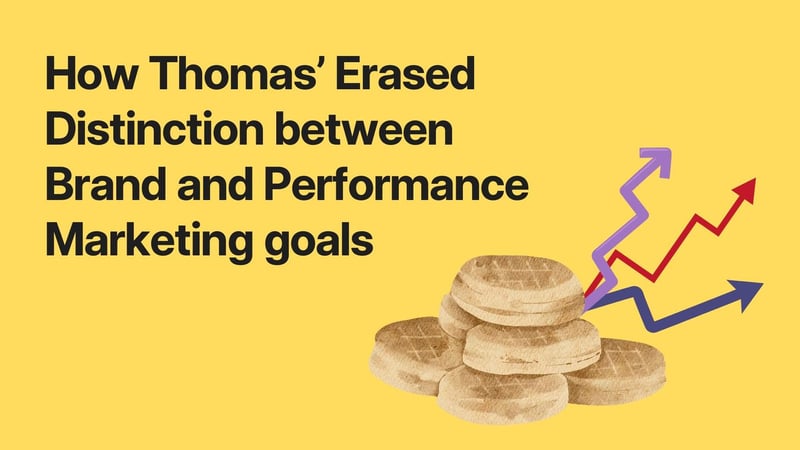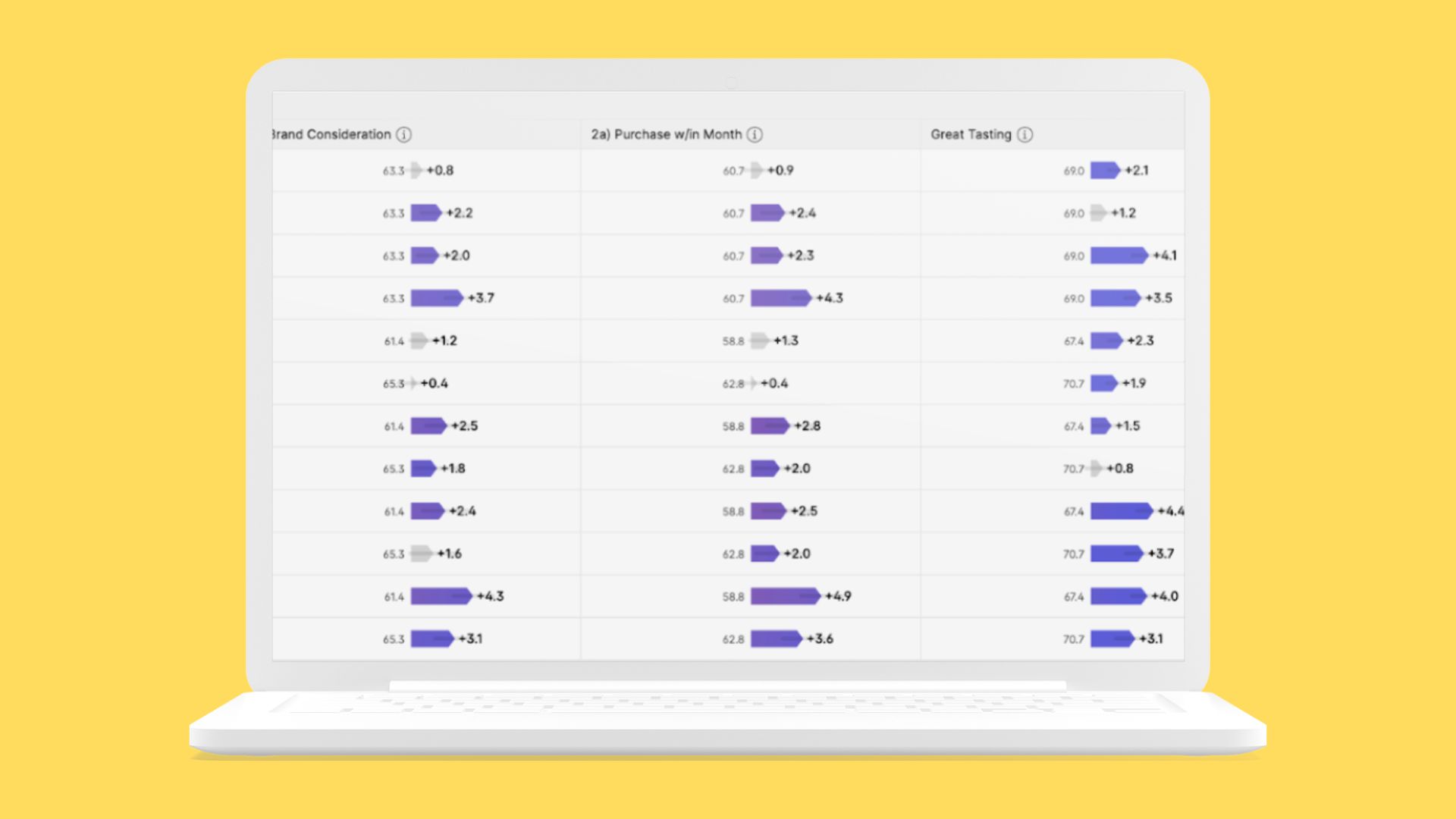How Thomas’ Partnered With Swayable's to Reach Younger Audiences
 By
Michelle Wiles
·
5 minute read
By
Michelle Wiles
·
5 minute read
By using online analytics to steer effective storytelling, the baked goods marketer is inspiring greater product awareness, affinity and offline purchases.

Takeaways
- Measuring brand marketing is challenging, particularly in the short run
- Thomas’ uses Swayable’s ad testing platform to quantify how their ads lift both brand and performance (sales) metrics
- Thomas’s originally tested fully produced ads with Swayable, but more recently uses the platform to test concepts and iterate into final ideas
Performance marketing offers marketers the ability to track, measure, and optimize digital ad campaigns. That is, if your marketing goal is to drive clicks and online conversions. If your goal is to drive in-store sales, or to build a brand, metrics like clicks and views are a distant proxy at best.
How can today’s marketers translate online campaigns into brand affinity and consideration?
That’s the question faced by Thomas’ Senior Brand Manager Mike Jensen. The brand team had big goals for Thomas’, including a brand refresh to attract a younger set of customers. Instead of relying on clicks and ad views, Jensen turned to Thomas’ creative testing partner, Swayable, to assess how the creative concepts would drive brand affinity, education, and finally, how ads persuade audiences to shop Thomas’ in-store.

Swayable uses a series of data-science based surveys and advanced analytics to determine how messaging such as ad creative changes minds.
The analytics company, founded in 2017, got its start by working with political campaigns to determine which ads would persuade people to vote. Swayable has since expanded into brands, and has worked with Thomas’ and its Bimbo Bakeries USA baked goods siblings for the past three years.
“Our relationship with Swayable has evolved in a number of important ways,” said Mike Jensen, Senior Brand Manager for Thomas'.
The focus group enters the 21st century
Amid a practically endless array of audience analytics providers, Swayable stands out for its science-backed approach, a mix of statistical and survey techniques designed to understand marketing effectiveness. In essence, Swayable represents the updated version of the in-person focus group.
In the past, a random set of consumers would gather in a physical conference room where executives analyzed the group’s opinions about various ad campaign samples from behind a two-way mirror. Swayable brings the focus group into the digital spheres of the 21st century.
The analytics platform does this in a number of ways.
Swayable’s digital sampling platform puts a brand’s creative executions and messaging before robust sample sizes in the 1000s of consumers. Swayable then measures how creative concepts affect various measures of brand sentiment in just a few hours. Perhaps most unique is Swayable’s use of a placebo. The platform diverts a random sample of the test audience to view an unrelated campaign (forming a control group). The control audience answers the same questions as the audiences who viewed the ad creative, allowing brands and agencies to not only compare the strength of different ideas, but isolate how each of their ideas shift perception from a baseline established by the placebo group.
The key to consumer insights
Swayable is not just a digital bridge to past methods of sifting through consumer tastes. At a time when economic pressures tend to drive marketing dollars away from branding efforts and towards performance, Swayable’s ultimate aim is to align both performance and branding goals.
The way Swayable CEO James Slezak sees it, branding and performance metrics should be viewed as mutually self-reinforcing. After all, people purchase products from brands they feel good about. Being able to establish the relationship between brand affinity and purchase intent represents a complete circle for the advertising/marketing mix.
“Brands have always relied on focus groups to get a sense of whether their messaging is having an impact,” Slezak said. “At the same time, everybody recognizes the traditional model doesn’t provide statistical measurement. It's useful from a qualitative perspective. We wanted to take the focus groups model and put it in a digital context, where we’ve all come to expect a clear level of scientific proof when measuring marketing’s impact.”
In Swayable’s updated model, the company designs randomized controlled trial experiments to reveal how ads shift consumer attitudes.
Slezak noted that the typical online metrics like clicks and views tend to be lacking when it comes to driving marketing outcomes that balance performance and brand objectives:
“If your goal is to get an immediate conversion — click here, buy now, act now on this discount — you can A/B test to see what drove clicks. The problem is that that is a measure of performance that does not apply if the story is about changing an attitude.”
Marketing is generally defined as an attempt to lift consumer demand for a product/service or increase brand favorability. Despite how embedded ecommerce is in our lives, people do not simply make a purchase after seeing one ad unit on Facebook or Google, Slezak noted.
“Most products are bought in a physical store — and more often than not, months after being exposed to an ad,” Slezak said. “Over the last few years, the advertising industry has lost sight of the fact that digital still struggles to provide evidence of what consumers see before ultimately deciding to purchase in-store. We're trying to give folks the real evidence about the cause and effect that we know exists.”

To help Thomas’ tell its brand story, Swayable focused on nailing what connects online advertising and offline shopping. It also sought to uncover the potential links and divides between national and local messages.
Testing the creative: how to reach no-nonsense moms
The brief Thomas’ had for Swayable was clear: examine four different creative concepts to determine which would be most likely to drive purchase intent, inspire recommendations to friends, and raise brand favorability.
Typically, Thomas’ sends Swayable finished ads to test which ones to move forward with. This time, Jensen and his team tested at the concept level, testing graphics of what an ad might look like. These bare bones ad concepts were put into Swayable to measure how the concepts drove consideration and brand favorability on a sample of nearly 10,000 consumers.

“Putting completed work before focus groups takes time and money,” Jensen said. “When we began talking about our plans for this campaign, Swayable told us about testing concepts first. This effort started off with a huge save to our budget by unlocking ideas we didn’t know we had.”
The spots used a mix of humor along with attempts to tug at emotional heartstrings.
“With humor, not everyone finds the same things funny,” said Jensen. “Primarily, we wanted to make sure we weren’t saying anything polarizing to consumers. It was a gut check. Swayable’s metrics showing the positive or negative sentiments helped us land on the two commercials that went to final production.”
No question was too small when Swayable tested consumer reactions to the ads’ messaging and style, Slezak said.
Should they use edgy emojis and jokey tones? Should the focus be on the value proposition? Should health or snackability or taste be the central point?
“These are all choices that marketers face and debate every day,” Slezak said.
To know when the balance and synthesis of branding and performance goals has been achieved, it’s simply a matter of looking at how the marketing resonated, Slezak added.
“By resonate, we don't just mean someone clicked ‘thumbs up’ on Facebook or clicked and viewed the ad,” Slezak said. “We mean: the consumer made it clear they want to buy Thomas’ English Muffins next time they’re in the supermarket. That's what successful performance and successful brand marketing means for that ad unit.”
Interested in testing out Swayable’s digital testing platform for yourself? Book a 15 minute demo
